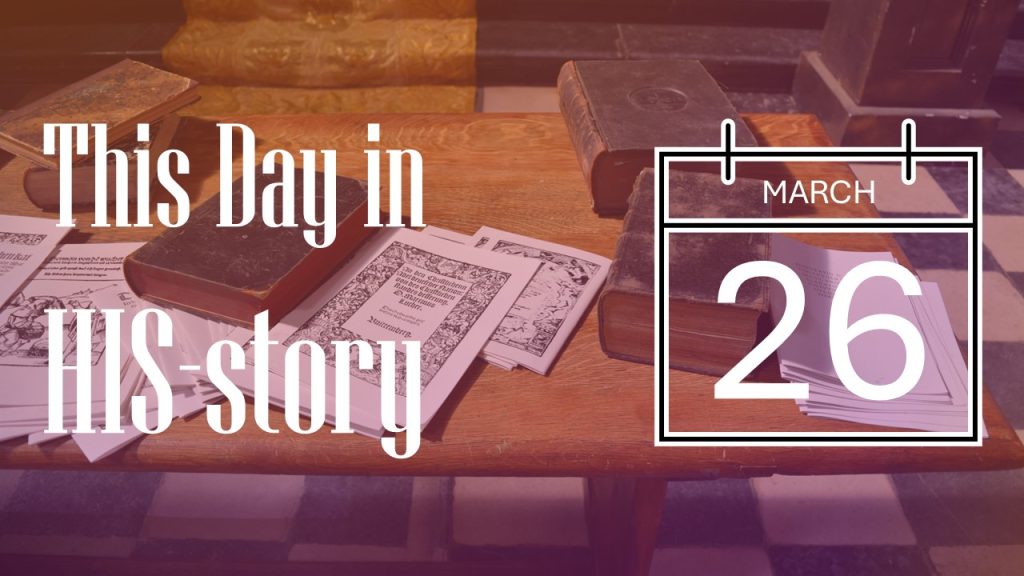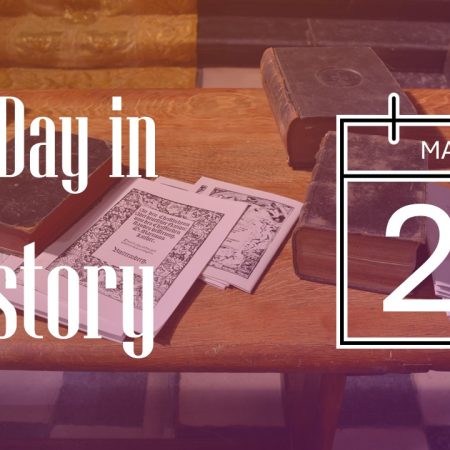
687
A lowly shepherd named Cuthbert became a monk after he had a vision in which he saw the soul of the Celtic missionary Aidan carried to heaven by angels. In entering the church, he was influenced by one of his playmates, who prophesied that one day he would become a bishop. Like Aidan, Cuthbert was a monk in the Irish tradition. In the seventh century, the Irish observed Easter on a different date than Rome and cut their hair differently, too. This prompted spats in England. King Alhfrith even refused to allow Abbot Eata and Cuthbert to settle at Ripon unless they agreed to the Roman forms.

The issue was resolved at the synod of Whitby in 664, which opted for the Roman observances. Cuthbert accepted the decision. A hardworking preacher, he spread the gospel throughout parts of Northumbria. According to Bede, “He was mostly accustomed to travel to those villages which lay in out-of-the-way places among the mountains, which by their poverty and natural horrors deterred other visitors. Eata made him prior of Lindisfarne although his own inclination was to become a hermit. Eventually he was allowed to live alone on the Isle of Farne where many visited him for spiritual advice.
His solitude did not last. On this day, March 26, 685, he was named bishop of Hexam. Rather than leave Lindisfarne, he swapped sees with Eata and became bishop of Lindisfarne instead, after which he was consecrated at York. He remained a man of deep spiritual sensitivity. His biographers said he never could celebrate mass without tears, so strongly did Christ’s sacrifice affect him. Two years after becoming bishop, Cuthbert died. But his story had only begun.
Eleven years later, in 698, his body was dug up. It had not decayed. This awed everyone. Surely it was proof of his sanctity!
In the Medieval way, he was venerated. People prayed to him. Traditions grew around him. Admirers wrote and embellished his story. In his honor, monks produced The Lindisfarne gospel, one of the most elegant English manuscripts ever illuminated. Bede researched his life and wrote of prophecies, miracles of healing and meals from God.
The monks moved Cuthbert’s body in time to save it from the Viking destruction of Lindisfarne. Cuthbert’s shrine in Durham was considered one of the holiest places of Medieval England. When King Henry VIII sent commissioners to pillage the tomb, Cuthbert was found still incorrupt. Out of respect, the king’s men permitted him to be reburied. Objects from his tomb survive to this day.
809
LUDGER did not let the pains of old age prevent him from doing God’s work. On Passion Sunday (the fifth Sunday of Lent, two weeks before Easter) the beloved priest preached at Coesfeld early in the morning and then at Billerbeck before noon. (Both are in the Westphalia region of modern Germany.) He died peacefully that night, in the early hours of this day, 26 March 809. His disciples and his sister were by his bed.

A Frisian, Ludger was born near modern Utrecht, Netherlands. His biographers said that from an early age he was deeply interested in spiritual questions. As a boy he had the joy of meeting the great missionary Boniface “when the hair of his head was white and his body was decrepit with old age.” Boniface’s evident holiness inspired Ludger to ask to be schooled by Gregory, a disciple of Boniface. Years later, Ludger wrote an affectionate account of Gregory’s life.
In 767, Ludger accompanied Alubert to York. Alubert was returning to England to receive consecration as a bishop. Ludger studied in York at the school of Alcuin, the greatest teacher of that age, but had to leave when his travel companions returned to the continent. He immediately petitioned Gregory for permission to return to York for more study. Obtaining reluctant assent, he spent three and a half more years with Alcuin.
Ludger chose to preach the gospel among his own people, where his knowledge of language and customs made it easier for him to win souls. At places where they sacrificed to their gods, he founded churches, and taught them to worship the only God. Where a spring was consecrated to an idol, he sanctified its waters by administering baptism there. He restored sight to a blind Frisian skald (singer of heroic poetry), converting him to Christianity.
However, Wittikind, king of the Saxons, attacked Frisia’s Christians, forcing Ludger to abandon his mission. He visited Pope Adrian I in Rome, then spent three years in a Benedictine monastery. When Charlemagne had subdued the Saxons, Ludger offered to work among them. His gentleness converted more of them than did Charlemagne’s forced baptisms. Ludger founded the monastery from which the city of Münster, Germany, takes its name.
His success was attributed to his great zeal for God. Once Emperor Charlemagne summoned Ludger intending to question him about his failure to richly decorate churches. (He preferred to use the money for charity.) Ludger kept the emperor waiting while he finished divine service. When Charlemagne asked why it had taken three messengers to get him to report, Ludger replied, “God is to be preferred to you, O King, and to all men.” After that Charlemagne held Ludger in high regard.
1889
The Navajo Indians gave Faye Edgerton a name: “The One Who Understands.” The reason was simple: she had spent close to half a century with them, learning their language (they called it Dine bizaad) and translating the New Testament into it. To the Indians it now seemed as if God spoke Navajo! In fact, they challenged her when she tried to revise it. How dare she change God’s words!

Faye Edgerton was born on this day, March 26, 1889. Her youth was one long social whirl, although she did well in school and became a competent musician. She had sought God at a young age and even become involved in church work, but had never known Him as a presence in her life. A bout with scarlet fever nearly killed her and left her virtually deaf for several days. This forced her to acknowledge her purposeless ways. When her hearing returned, she praised God. From then on, she was His.
Immediately, she showed a new concern for her parents. And as soon as circumstances permitted, she studied at Moody Bible Institute and became a missionary. On a long voyage across the Pacific, she studied Korean. By the time she reached the peninsula, she could read it well. But Korea proved hard to her. The cold sapped her strength. She had a nervous breakdown her first year. But she learned lessons of obedience. Finally bad health forced her home.
After her father died, she took up mission work in Arizona, where she hoped the climate would be kinder to her health. Increasingly she became aware that the Navajo people needed the Bible in their own language. After taking a course at the Summer Institute of Linguistics, she became convinced she could do the work and that God wanted her to. But finding the necessary time was impossible. She decided to leave the Presbyterian mission and join Wycliffe Bible Translators.
It was still many years before the New Testament became a Navajo book. But she had several willing helpers. One of them, Roger, had taught himself to read his native language from an English-Navajo dictionary while recuperating in a hospital! He once said, “This is not just a missionary talking to us in another language–this is God’s word in Navajo. It is just like God talking!” The expression for soul was “that which stands up in you.”
Near the end of the translation, Faye became worn out. And then she was thrown out of a car and dragged a great distance. Miraculously she survived with minor injuries. In 1954, the completed translation was sent to the American Bible Society for publication. It was not until 1956 after proofreading, revisions and corrections that the book finally came off the press. It was an instant success, a bestseller in the tribe. It spurred the Navajo to new efforts to learn to read their own tongue. Even before the book was off the press, Faye, now in her sixties, with a helper named Faith, began learning Apache so they could translate the Bible into that language. Nine years later the Apache New Testament also went to press. But Faye did not stop working on new translations and revisions until just days before her death in 1968.
